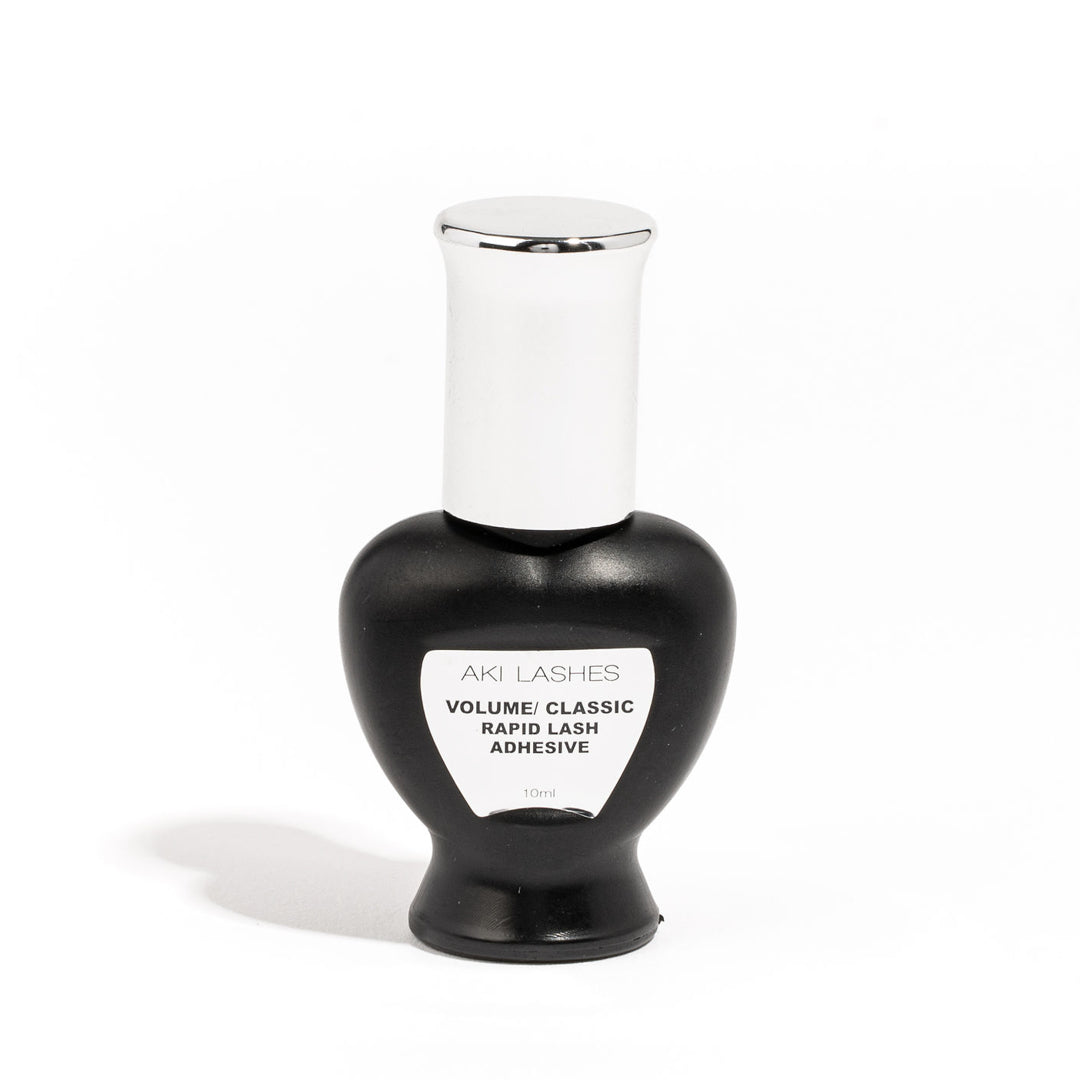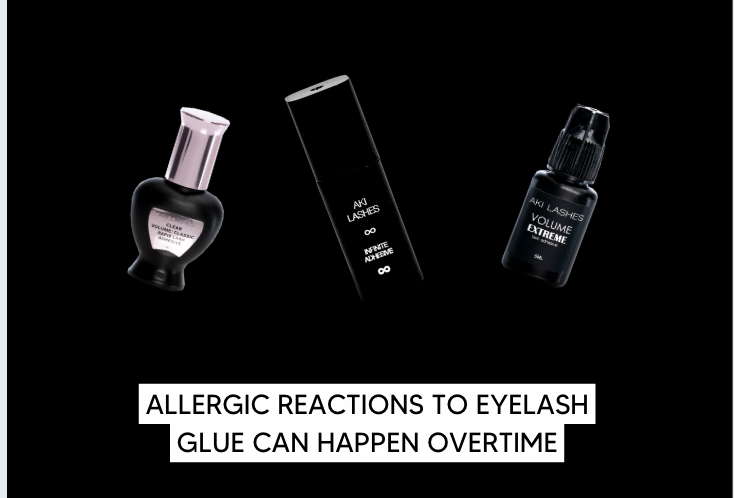As a lash artist, you know how important it is to deliver flawless lashes every time. However, one challenge that can make any lash appointment stressful is dealing with lash extension allergies. Clients can sometimes experience reactions to the products used in the application, particularly the lash glue, which can cause discomfort, irritation, or even more severe symptoms.
In this blog post, we’ll dive into the truth about lash extension allergies, how to spot reactions early, and what you can do to protect both your clients and your business. With Aki Lashes’ high-quality products and expert training, you can ensure a safe and satisfying experience for every client, minimizing the risk of allergic reactions and lash sensitivity.
What Causes Lash Extension Allergies?
1. Lash Glue Ingredients
The most common culprit behind eyelash extension reactions is the lash adhesive used during the application. Many lash glues contain cyanoacrylate, a fast-drying ingredient that bonds the extensions to natural lashes. While effective, cyanoacrylate can also cause allergic reactions in some individuals.
Even the slightest exposure to this ingredient can trigger eye irritation, redness, swelling, or itchiness. Some clients may have a higher sensitivity to the adhesive, especially if they have a history of allergies to other products, such as certain cosmetics or latex.
2. Environmental Sensitivity
Apart from the glue itself, other factors can exacerbate lash sensitivity. For instance, dry air, smog, or pollution can irritate the eyes and make a client more likely to experience discomfort after an application. Clients with dry eyes, eczema, or sensitive skin may also be more prone to reactions.
3. The Extension Materials
Although less common, the materials of the lash extensions themselves can also cause reactions. For example, some low-quality lashes or poorly manufactured lashes may contain chemicals or irritants that trigger sensitivity in certain individuals.
Signs and Symptoms of Lash Glue Allergies
Recognizing an allergic reaction is crucial to preventing more severe issues. While minor irritation may occur during the first few hours after an application, severe reactions may develop over time. Here are the main symptoms of an eyelash extension reaction to watch for:
1. Itchy Eyes or Lash Line
The most common sign of an allergy is itching around the eyes or along the lash line. If a client feels like their eyes are constantly irritated or scratchy, it could be a sign of a reaction to the lash glue.
2. Redness and Swelling
Allergic reactions often cause redness or swelling
3. Excessive Tearing
An excessive watery discharge from the eyes, also known as watering, can indicate a reaction. This is especially true if the eyes become red and irritated at the same time.
4. Pain or Sensitivity
If a client feels a sharp or throbbing pain in their eyes or around their lash line, they could be experiencing an allergic reaction. Sensitivity to light or even a mild headache can accompany a lash glue allergy.
5. Bumps or Rash on the Lash Line
More severe allergic reactions can cause small bumps or a rash around the lash line. If you notice these symptoms, it’s time to remove the lashes immediately and advise your client to seek medical attention if needed.
6. Difficulty Opening Eyes
In rare cases, a severe allergic reaction can cause extreme swelling, making it difficult for the client to open their eyes. This requires immediate attention and care.
How to Prevent Lash Extension Allergies
While it’s impossible to guarantee that a client won’t experience some form of lash sensitivity, there are steps you can take to reduce the risk of allergic reactions:
1. Use High-Quality Lash Glue
One of the best ways to minimize the risk of allergies is by using high-quality lash adhesives that are formulated for sensitive skin. At Aki Lashes, we offer adhesives that are low-fume and hypoallergeni
2. Perform a Patch Test
Before performing a full set of extensions, always recommend a patch test for first-time clients. A patch test involves placing a small amount of adhesive on their skin (typically behind the ear or on the inner forearm) and waiting 24-48 hours to see if any reaction occurs. If there’s no reaction, you can proceed with the application. If there is, it’s best to find a hypoallergenic adhesive or alternative for that client.
3. Choose the Right Adhesive for Sensitive Clients
Not all clients will have a reaction to the same product. If a client has a history of allergies or sensitive skin, it’s crucial to use a sensitive-formula adhesive. Our Aki Lashes line offers a range of adhesives with varying drying times and strengths, so you can choose one that works best for your clients' needs.
4. Keep the Application Area Clean
Maintaining a clean and hygienic workspace is essential in preventing eye irritation. Clean the client’s natural lashes thoroughly before application to remove oils, dirt, and makeup residue. This helps ensure a strong bond between the natural lashes and extensions, which can also minimize irritation from product build-up.
5. Educate Your Clients on Aftercare
Proper lash aftercare is just as important as the application process. Educate your clients about how to take care of their lashes after the procedure, including:
- Avoiding water and steam for the first 24-48 hours to allow the glue to fully cure.
- Cleaning the lashes regularly with a mild, oil-free cleanser to remove dirt and bacteria.
- Avoiding rubbing the eyes or using harsh makeup removers near the lash line.
The better the aftercare, the less likely your clients are to experience sensitivity or irritation.
Common Mistakes and How to Avoid Them
1. Using Low-Quality Products
One of the biggest mistakes a lash artist can make is using low-quality adhesives or lashes. These can cause reactions, poor retention, or even damage to your client’s natural lashes. Always invest in reputable, safe, and tested products to ensure the best results for your clients.
2. Ignoring Client Sensitivities
Always ask your clients about any known allergies or sensitiviti
3. Overapplying Glue
Using too much glue can cause the extensions to feel heavy and uncomfortable, leading to eye irritation or lash sensitivity. Apply just enough adhesive to bond the extensions without overdoing it.
FAQs
Q: What should I do if my client experiences an allergic reaction?
A: If you notice signs of an allergic reaction, immediately remove the extensions and recommend your client seek medical advice if the symptoms are severe. Mild reactions can usually be treated with cool compresses and anti-inflammatory eye drops.
Q: How can I prevent allergic reactions in the future?
A: Use hypoallergenic adhesives, perform patch tests, and educate your clients on proper aftercare to minimize the chances of lash sensitivity or eyelash extension reactions.
Conclusion: Keep Your Clients Safe & Happy
Understanding lash glue allergies and how to spot them early can protect both you and your clients from discomfort. By using the right products, performing patch tests, and educating your clients on proper aftercare, you can reduce the risk of reactions and ensure a positive experience.
At Aki Lashes, we specialize in providing high-quality lash extension products and expert training to help you grow your business while keeping your clients safe and happy. Shop now for our premium adhesives or sign up for training to enhance your skills and become a trusted lash artist!

